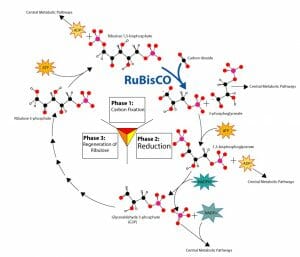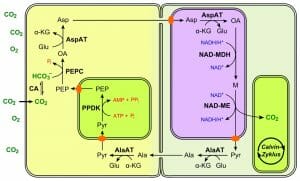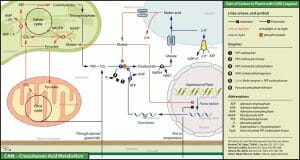C3, C4 and CAM are the three different processes that plants use to fix carbon during the process of photosynthesis. Fixing carbon is the way plants remove the carbon from atmospheric carbon dioxide and turn it into organic molecules like carbohydrates.
Comparison Chart
| Plant Characteristic | C3 Pathway | C4 Pathway | CAM Pathway |
|---|---|---|---|
| Photorespiration Rate | High | Low / Negligible | Very Low / Negligible |
| Leaf Anatomy | Typical | Kranz | Xeromorphic |
| Typical Environments | All | Tropical, elevated daytime temperatures, drought | Dry, arid |
| Stoma Open During the Day? | Yes | Yes | No |
| Number of Steps in Pathway | 1 | 2 | 2 |
| First Molecule Produced in Pathway | 3-phophoglyceric acid | Malic acid or aspartic acid | Malate |
| Uses the Calvin Cycle? | Yes | Yes | Yes |
C3 Plants
The C3 pathway gets its name from the first molecule produced in the cycle (a 3-carbon molecule) called 3-phosphoglyceric acid. About 85% of the plants on Earth use the C3 pathway to fix carbon via the Calvin Cycle. During the one-step process, the enzyme RuBisCO (ribulose bisphosphate carboxylase/oxygenase) causes an oxidation reaction in which some of the energy used in photosynthesis is lost in a process known as photorespiration. The result is about a 25% reduction in the amount of carbon that is fixed by the plant and released back into the atmosphere as carbon dioxide. The carbon fixation pathways used by C4 and CAM plants have added steps to help concentrate and reduce the loss of carbon during the process. Some common C3 plant species are spinach, peanuts, cotton, wheat, rice, barley and most trees and grasses.

The image above shows the C3 carbon fixation pathway also known as the Calvin Cycle, used my many types of plants.
C4 Plants
The C4 process is also known as the Hatch-Slack pathway and is named for the 4-carbon intermediate molecules that are produced, malic acid or aspartic acid. It wasn’t until the 1960s that scientists discovered the C4 pathway while studying sugar cane. C4 has one step in the pathway before the Calvin Cycle which reduces the amount of carbon that is lost in the overall process. The carbon dioxide that is taken in by the plant is moved to bundle sheath cells by the malic acid or aspartic acid molecules (at this point the molecules are called malate and aspartate). The oxygen content inside bundle sheath cells is very low, so the RuBisCO enzymes are less likely to catalyze oxidation reactions and waste carbon molecules. The malate and aspartate molecules release the carbon dioxide in the chloroplasts of the bundle sheath cells and the Calvin Cycle begins. Bundle sheath cells are part of the Kranz leaf anatomy that is characteristic of C4 plants.
About 3% or 7,600 species of plants use the C4 pathway, about 85% of which are angiosperms (flowering plants). C4 plants include corn, sugar cane, millet, sorghum, pineapple, daisies and cabbage.

The image above shows the C4 carbon fixation pathway.
CAM Plants
Plants that use crassulacean acid metabolism, also known as CAM plants, are succulents that are efficient at storing water due to the dry and arid climates they live in. The word crassulacean comes from the Latin word crassus which means “thick.” There are over 16,000 species of CAM plants on Earth including cacti, sedum, jade, orchids and agave. Succulent plants like cacti have leaves that are thick and full of moisture and can also have a waxy coating to reduce evaporation.
CAM plants keep their stoma close during the day to prevent water loss. Instead, the stoma are opened at night to take in carbon dioxide from the atmosphere. The carbon dioxide is converted to a molecule called malate which is stored until the daylight returns and photosynthesis begins via the Calvin Cycle.

The image above shows the CAM carbon fixation pathway used by plants that live in dry and arid environments.
References
- Carbon Fixation. (n.d.). In Wikipedia. Retrieved August 5, 2017 from https://en.wikipedia.org/wiki/Carbon_fixation
- Difference between C3, C4 and CAM plants. (n.d.). In MajorDifferences.com. Retrieved August 5, 2017 from http://www.majordifferences.com/2014/04/difference-between-c3-c4-and-cam-plants.html#.WYW_LumQzGg
C3, C4 and CAM Plants
No comments:
Post a Comment